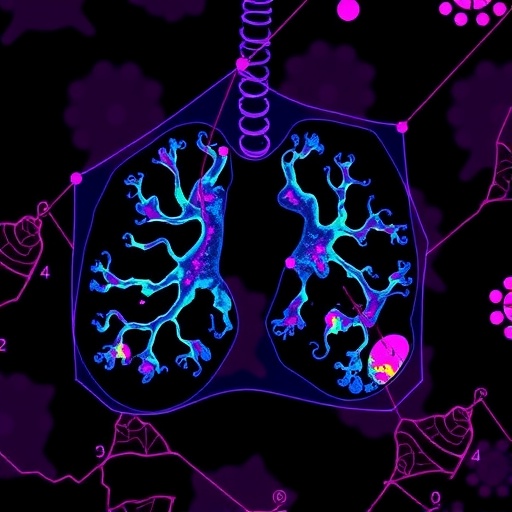
In a groundbreaking study published in Cell Death Discovery in 2025, researchers have unveiled a complex molecular interplay linking MUC1-C, a transmembrane oncoprotein, with the activation of APOBEC3 cytidine deaminases and endogenous retroviruses (ERVs) in non-small cell lung cancer (NSCLC) cells. This discovery sheds light on an intricate regulatory axis that fuels genome instability and antiviral responses in NSCLC pathogenesis, potentially opening new therapeutic avenues targeting these intertwined pathways.
Lung cancer remains one of the leading causes of cancer-related mortality worldwide, with NSCLC constituting approximately 85% of all lung cancer cases. Despite advances in targeted therapies and immunotherapies, NSCLC prognosis remains grim, underscoring the urgent need for better understanding of its molecular underpinnings. The current study delves into the role of the oncogenic MUC1-C subunit, previously implicated in tumor progression and resistance, highlighting its integration with APOBEC3 family members and ERVs, elements traditionally viewed as genomic threats but increasingly recognized for their influence on cancer biology.
APOBEC3 enzymes represent a family of cytidine deaminases involved in innate immunity, capable of inducing C-to-U mutations in single-stranded DNA during viral infection. While their antiviral role is crucial, abnormal APOBEC3 activation has been implicated in promoting mutational burden and genomic instability in various cancers, including lung cancer. The researchers demonstrate that MUC1-C directly modulates the expression and enzymatic activity of APOBEC3 cytidine deaminases in NSCLC cells, suggesting a pivotal role for MUC1-C in fine-tuning mutagenic processes linked to tumor heterogeneity and evolution.
.adsslot_8IvVsOhg4J{width:728px !important;height:90px !important;}
@media(max-width:1199px){ .adsslot_8IvVsOhg4J{width:468px !important;height:60px !important;}
}
@media(max-width:767px){ .adsslot_8IvVsOhg4J{width:320px !important;height:50px !important;}
}
ADVERTISEMENT
The study further reveals a surprising association between MUC1-C activity and the reactivation of endogenous retroviruses (ERVs). ERVs are remnants of ancient viral infections integrated into the human genome, generally silenced but capable of resurging under pathological conditions such as cancer. Detection of ERV transcripts and viral-like elements can stimulate antiviral immune responses or contribute to oncogenic signaling. Here, the data implies that MUC1-C orchestrates ERV expression patterns, possibly through epigenetic reprogramming or direct transcriptional regulation, therefore linking viral mimicry mechanisms to cancer cell survival and immune evasion.
Utilizing comprehensive molecular assays and RNA sequencing techniques, the investigators quantified transcripts of multiple APOBEC3 isoforms alongside ERV markers in cultured NSCLC lines with manipulated MUC1-C expression. Their findings indicate a positive correlation between MUC1-C levels and APOBEC3/ERV induction, accompanied by increased cytidine deaminase activity driving mutagenesis. Functional experiments demonstrate that silencing MUC1-C leads to diminished APOBEC3 expression and reduced ERV reactivation, emphasizing a causative regulatory axis rather than a mere association.
At the signaling level, the report posits that MUC1-C triggers intracellular cascades involving NF-κB and STAT pathways, known modulators of immune and inflammatory responses, to promote the transcriptional activation of APOBEC3 and ERV loci. Such pathways are often hyperactivated in cancer, bolstering prosurvival signals while contributing to the cancer mutational landscape. This mechanistic insight positions MUC1-C as a master integrator of oncogenic stress responses converging on innate immune effectors, thereby fostering an environment conducive to tumor aggressiveness and resistance.
The implications of these findings are multifaceted. First, the MUC1-C–APOBEC3–ERV axis represents a novel mechanism by which NSCLC cells can increase their mutational repertoire, facilitating clonal evolution and adaptation. This could partly explain the observed heterogeneity and rapid emergence of therapy-resistant subpopulations within tumors. Second, ERV activation may elicit chronic inflammatory milieus or alter immunogenicity, affecting tumor-immune interactions. Understanding how MUC1-C modulates these processes could enable development of combination therapies that target both oncogenic signaling and immune evasion.
Of particular significance is the therapeutic potential arising from MUC1-C inhibition. Prior studies have highlighted MUC1-C as a viable target due to its restricted expression in normal tissues and overexpression in diverse malignancies. By interfering with MUC1-C function, it may be possible to curtail APOBEC3-driven mutagenesis and ERV-mediated oncogenic signaling simultaneously. This dual blockade could limit tumor adaptability and sensitize NSCLC cells to immunotherapy or DNA-damaging agents. Current efforts focusing on small molecules or antibody derivatives to inhibit MUC1-C warrant reassessment in light of these novel insights.
Moreover, the study raises intriguing questions about the interplay between host innate immune mechanisms and cancer evolution. APOBEC3 enzymes, while defensive against exogenous viruses, may paradoxically facilitate cancer progression through mutagenesis when dysregulated. ERVs, as relic viral elements, might serve as both triggers and targets within this axis. The link established by MUC1-C suggests a coordinated biological program where tumor cells hijack antiviral pathways for their benefit, blurring the lines between infection, immunity, and malignancy.
From a diagnostic perspective, components of this axis such as APOBEC3 expression patterns or ERV signatures could emerge as biomarkers predicting NSCLC aggressiveness or therapeutic responsiveness. Monitoring these molecular readouts may aid patient stratification or assessment of MUC1-C inhibitor efficacy in clinical trials. Additionally, the elucidation of this pathway contributes to a growing paradigm recognizing the importance of endogenous retroelements and mutagenic enzymes in cancer biology.
The methodological rigor of this investigation, incorporating gene knockdowns, enzymatic assays, transcriptomic profiling, and signaling pathway analyses, strengthens the credibility of its conclusions. By integrating these approaches, the authors provide a comprehensive picture of how MUC1-C exerts control over APOBEC3 activity and ERV expression, further reinforced by functional validation experiments. Such depth of analysis is essential in decoding the complex networks driving tumor progression.
In sum, this seminal work uncovers a pivotal regulatory mechanism involving MUC1-C that synchronizes APOBEC3 cytidine deaminase activation with endogenous retrovirus expression in NSCLC cells. The identification of this integrated axis transforms our understanding of tumor biology, linking mutagenic enzymes and ancient viral elements under the governance of a well-known oncoprotein. These findings hold promise for innovative therapeutic interventions targeting this nexus to attenuate tumor evolution, enhance treatment efficacy, and ultimately improve patient outcomes in NSCLC.
Future research should aim at elucidating the precise molecular interfaces between MUC1-C and the transcriptional machinery regulating APOBEC3 and ERV loci, as well as exploring the in vivo relevance of this axis in patient-derived xenografts or clinical specimens. Additionally, investigating how this pathway interacts with the tumor microenvironment and immune cell infiltration could reveal synergistic vulnerabilities. The discovery of the MUC1-C–APOBEC3–ERV axis thus opens an exciting frontier in cancer research, blending virology, immunology, and oncology into a cohesive framework.
As oncology pivots toward precision medicine, understanding and exploiting such unique molecular circuits remain paramount. The study by Haratake et al. not only deepens our mechanistic grasp of NSCLC biology but also exemplifies the power of interdisciplinary research in uncovering latent viral elements and innate immune effectors as key contributors to cancer pathogenesis. These insights reinforce the concept that cancer is not merely uncontrolled proliferation but a sophisticated manipulation of host pathways, providing fertile ground for transformative therapies.
In conclusion, the integration of APOBEC3 cytidine deaminases and endogenous retrovirus activation by MUC1-C in NSCLC cells represents a paradigm shift, redefining the interplay between oncogenic signaling, mutagenesis, and viral mimicry. This multifaceted axis underscores the intricate molecular choreography driving tumor progression and resistance, offering fresh targets for combating one of the deadliest forms of cancer. With continued exploration and therapeutic targeting of this network, new hope emerges for NSCLC patients facing limited options.
Subject of Research: Molecular mechanisms underlying the regulation of APOBEC3 cytidine deaminases and endogenous retroviruses by MUC1-C in non-small cell lung cancer.
Article Title: Activation of APOBEC3 cytidine deaminases and endogenous retroviruses is integrated by MUC1-C in NSCLC cells.
Article References:
Haratake, N., Takamori, S., Isozaki, H. et al. Activation of APOBEC3 cytidine deaminases and endogenous retroviruses is integrated by MUC1-C in NSCLC cells. Cell Death Discov. 11, 372 (2025). https://doi.org/10.1038/s41420-025-02673-9
Image Credits: AI Generated
DOI: https://doi.org/10.1038/s41420-025-02673-9
Tags: APOBEC3 cytidine deaminases functioncancer biology and retrovirus activationcancer-related antiviral responsesendogenous retroviruses in cancergenomic instability in NSCLClung cancer mortality causesMUC1-C and APOBEC3 interactionmutations induced by APOBEC3non-small cell lung cancer mechanismsNSCLC molecular pathwaysoncogenic role of MUC1-Ctherapeutic targets for lung cancer





